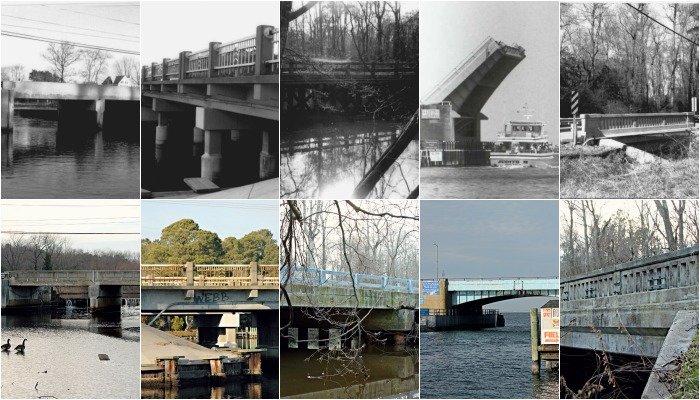Unbeknownst to many who call the Eastern Shore of MD home or reside in Worcester County, it is surprising to know that our coastline is covered in some of the oldest bridges in the entire country. Some bridges were constructed of Cypress trees removed for mining purposes. Others were created using concrete slabs and rationed steel bolts during times of sever depression.
The Bridges of Worcester County
Ocean City Drawbridge
|
1942- Constructed in 1942, the Ocean City Bridge is a double-leaf rollingbascule movable bridge; a drawbridge. A rolling lift bascule is one in which the center of rotation moves away from the opening when the span swings upward. Fenders (bumpers) were built in the water below the bridge to protect it from possible impact from ships and boats passing through the 30’ deep channel below.
The drawbridge is a recognizable icon of Ocean City. It crosses the Sinepuxent Bay and connects the mainland to the barrier island, marked as a vacation destination. The building of this bridge significantly impacted the growth of Ocean City. Ocean City’s position as an important resort area was a result of increased traffic flow to the oceanfront destination.
The bridge consists of 72 concrete slabs (that drivers are well aware of when crossing the bridge). One steel main span makes up the movable section. The bridge features a tender’s house located just one block above street level.
|
 |
| Photo: Above top photo taken by Julie Abell in December 1995 shows drawbridge open as boat passes. |  |
Herring Creek Bridge
|
1942- West Ocean City, MD’s decorative bridge over Herring Creek is one that hundreds of people cross on a daily basis yet don’t really know its history. The Herring Creek Bridge was built in 1942 and greatly influenced by the Art Deco architectural movement of the era. Art Deco styling is extremely noticeable in the bridge’s decorative parapet. The bridge also represents an early indication of the planning of dualized highways and the construction of twin bridges to carry separate lanes of traffic.
The chevron patterned metal railings between concrete posts were quite hip during the 1940’s and are making reappearances in modern bridge design today. The base of the bridge consists of concrete piles and timber bulkheads for protection from the tidewaters.
|
 |
| Photo: Above top photo taken Matt Hickson in February 1995. | .jpg) |
Bishopville Bridge
|
1900- The bridge that crosses Buntings Branch at the western edge of the village of Bishopville is one unlike any others in Worcester County. The bridge, along Route 367, is estimated to have been built in 1900 and is thus one of the earliest bridges ever built on the Eastern Shore.
Records state that the bridge was originally built for more efficient transportation networks and altered in 1935 so larger load capacities could travel across Buntings Branch. The bridge was built immediately following the First World War. Since then, several coastal storms have severely damaged the structure and resulted in repairs and added steel beams and jackets for protection against future storms. Unlike other creeks, streams, and branches, Buntings Branch is a very tidal waterway. The daily rise and fall of the tide is noticeable. Water also wells up at a man-made damn just close to the bridge’s base.
The only original elements of the Bishopville Bridge (that date back to pre-1935 additions) are the east abutment and part of the deck. The original bridge has been modified so much that it is no longer considered a significant example of World War I era bridge design.
|
 |
| Photo: Above top photo taken by Matt Hickson in February 1995. |  |
Libertytown Bridge
|
1941- The bridge marked by brown and white Pocomoke River Cypress Swamp signs on Route 374 in Libertytown/Berlin was one of few timber bridges in Worcester County. Built in 1941, the 120-foot bridge was built using composite timber across the great Pocomoke River. It is supported by two timber abutments and six bents made from local trees. A large copper plate holds the bridge together and is covered with concrete.
During the early ‘40’s, builders attempted to eliminate the use of critical materials and use materials that were abundant instead. Timber and reinforced concrete construction methods were used in many places where structural steel would ordinarily be used. In the case of reinforced concrete construction, workers were proportioned in order to keep the amount of reinforced steel used to a minimum. The Libertytown Bridge over the Pocomoke River was made using very little metal. The only steel used on the bridge were the bolts between the piles and the deck and those within the deck.
Bridges in Wicomico County that span the Pocomoke River mimic the wooden design of this Libertytown Bridge. In more recent years, the old wooden bridges has been covered in cement and updated for safety reasons.
|
Morris_German.png) |
| Photo: Above top photo taken by Morris German in March 1998. |  |
Whiton Road Bridge
|
1932 – Referred to as Bridge No. 23011, the bridge on Whiton Road (Route 354) just south of Whiton was built in 1932. The bridge runs north-south and allows for passage over the narrow Tilghman Race. The bridge is surrounded by farmland and wooded area with only 3 driveways within a 1-mile radius.
The Whiton Road Bridge is 31 feet, 4 inches long. The structure was made using concrete beams and a matching deck. The bridge has retained its character-defining elements: concrete slab work, pierced parapets, concrete abutments, and intricate wing walls. The only sign of modern times? The steel guard rails that lead up to and follow the bridge along the roadway.
The earliest concrete bridges in the nation featured a series of reinforced concrete beams integrated into a concrete slab. They were known as ‘T bridges’. The cross section resembled an uppercase ‘T’. The Whiton Road Bridge is a T bridge.
Only a few cracks and chips give represent the age of this structure.
|
 |
| Photo: Above top photo taken by Caroline Hall in March 1997. |  |
Colored photos taken by Ami Reist in January 2013. All black and white photos courtesy of the Maryland Historical Trust.









